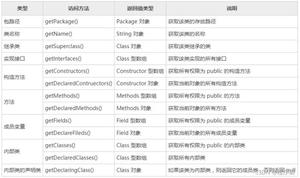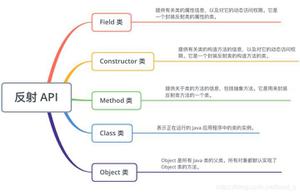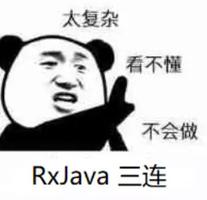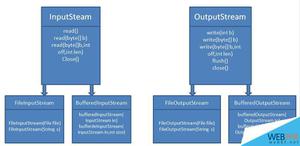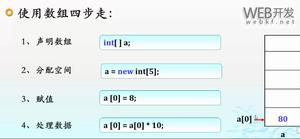java反射深入剖析(推荐)
本篇文章依旧采用小例子来说明,因为我始终觉的,案例驱动是最好的,要不然只看理论的话,看了也不懂,不过建议大家在看完文章之后,在回过头去看看理论,会有更好的理解。
下面开始正文。
【案例1】通过一个对象获得完整的包名和类名
package Reflect;
/**
* 通过一个对象获得完整的包名和类名
* */
class Demo{
//other codes...
}
class hello{
public static void main(String[] args) {
Demo demo=new Demo();
System.out.println(demo.getClass().getName());
}
}
【运行结果】:Reflect.Demo
添加一句:所有类的对象其实都是Class的实例。
【案例2】实例化Class类对象
package Reflect;
class Demo{
//other codes...
}
class hello{
public static void main(String[] args) {
Class<?> demo1=null;
Class<?> demo2=null;
Class<?> demo3=null;
try{
//一般尽量采用这种形式
demo1=Class.forName("Reflect.Demo");
}catch(Exception e){
e.printStackTrace();
}
demo2=new Demo().getClass();
demo3=Demo.class;
System.out.println("类名称 "+demo1.getName());
System.out.println("类名称 "+demo2.getName());
System.out.println("类名称 "+demo3.getName());
}
}
【运行结果】:
类名称 Reflect.Demo
类名称 Reflect.Demo
类名称 Reflect.Demo
【案例3】通过Class实例化其他类的对象
通过无参构造实例化对象
public Person(String name, int age) {
this.age=age;
this.name=name;
}
然后继续运行上面的程序,会出现:
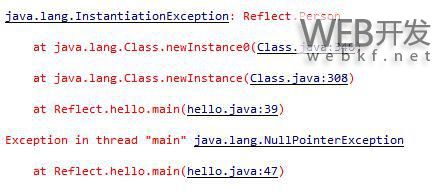
所以大家以后再编写使用Class实例化其他类的对象的时候,一定要自己定义无参的构造函数
【案例】通过Class调用其他类中的构造函数 (也可以通过这种方式通过Class创建其他类的对象)
package Reflect;
import java.lang.reflect.Constructor;
class Person{
public Person() {
}
public Person(String name){
this.name=name;
}
public Person(int age){
this.age=age;
}
public Person(String name, int age) {
this.age=age;
this.name=name;
}
public String getName() {
return name;
}
public int getAge() {
return age;
}
@Override
public String toString(){
return "["+this.name+" "+this.age+"]";
}
private String name;
private int age;
}
class hello{
public static void main(String[] args) {
Class<?> demo=null;
try{
demo=Class.forName("Reflect.Person");
}catch (Exception e) {
e.printStackTrace();
}
Person per1=null;
Person per2=null;
Person per3=null;
Person per4=null;
//取得全部的构造函数
Constructor<?> cons[]=demo.getConstructors();
try{
per1=(Person)cons[0].newInstance();
per2=(Person)cons[1].newInstance("Rollen");
per3=(Person)cons[2].newInstance(20);
per4=(Person)cons[3].newInstance("Rollen",20);
}catch(Exception e){
e.printStackTrace();
}
System.out.println(per1);
System.out.println(per2);
System.out.println(per3);
System.out.println(per4);
}
}
【运行结果】:
[null 0]
[Rollen 0]
[null 20]
[Rollen 20]
【案例】
返回一个类实现的接口:
package Reflect;
interface China{
public static final String name="Rollen";
public static int age=20;
public void sayChina();
public void sayHello(String name, int age);
}
class Person implements China{
public Person() {
}
public Person(String sex){
this.sex=sex;
}
public String getSex() {
return sex;
}
public void setSex(String sex) {
this.sex = sex;
}
@Override
public void sayChina(){
System.out.println("hello ,china");
}
@Override
public void sayHello(String name, int age){
System.out.println(name+" "+age);
}
private String sex;
}
class hello{
public static void main(String[] args) {
Class<?> demo=null;
try{
demo=Class.forName("Reflect.Person");
}catch (Exception e) {
e.printStackTrace();
}
//保存所有的接口
Class<?> intes[]=demo.getInterfaces();
for (int i = 0; i < intes.length; i++) {
System.out.println("实现的接口 "+intes[i].getName());
}
}
}
【运行结果】:
实现的接口 Reflect.China
(注意,以下几个例子,都会用到这个例子的Person类,所以为节省篇幅,此处不再粘贴Person的代码部分,只粘贴主类hello的代码)
【案例】:取得其他类中的父类
class hello{
public static void main(String[] args) {
Class<?> demo=null;
try{
demo=Class.forName("Reflect.Person");
}catch (Exception e) {
e.printStackTrace();
}
//取得父类
Class<?> temp=demo.getSuperclass();
System.out.println("继承的父类为: "+temp.getName());
}
}
【运行结果】
继承的父类为: java.lang.Object
【案例】:获得其他类中的全部构造函数
这个例子需要在程序开头添加import java.lang.reflect.*;
然后将主类编写为:
class hello{
public static void main(String[] args) {
Class<?> demo=null;
try{
demo=Class.forName("Reflect.Person");
}catch (Exception e) {
e.printStackTrace();
}
Constructor<?>cons[]=demo.getConstructors();
for (int i = 0; i < cons.length; i++) {
System.out.println("构造方法: "+cons[i]);
}
}
}
【运行结果】:
构造方法: public Reflect.Person()
构造方法: public Reflect.Person(java.lang.String)
但是细心的读者会发现,上面的构造函数没有public 或者private这一类的修饰符
下面这个例子我们就来获取修饰符
class hello{
public static void main(String[] args) {
Class<?> demo=null;
try{
demo=Class.forName("Reflect.Person");
}catch (Exception e) {
e.printStackTrace();
}
Constructor<?>cons[]=demo.getConstructors();
for (int i = 0; i < cons.length; i++) {
Class<?> p[]=cons[i].getParameterTypes();
System.out.print("构造方法: ");
int mo=cons[i].getModifiers();
System.out.print(Modifier.toString(mo)+" ");
System.out.print(cons[i].getName());
System.out.print("(");
for(int j=0;j<p.length;++j){
System.out.print(p[j].getName()+" arg"+i);
if(j<p.length-1){
System.out.print(",");
}
}
System.out.println("){}");
}
}
}
【运行结果】:
构造方法: public Reflect.Person(){}
构造方法: public Reflect.Person(java.lang.String arg1){}
有时候一个方法可能还有异常,呵呵。下面看看:
class hello{
public static void main(String[] args) {
Class<?> demo=null;
try{
demo=Class.forName("Reflect.Person");
}catch (Exception e) {
e.printStackTrace();
}
Method method[]=demo.getMethods();
for(int i=0;i<method.length;++i){
Class<?> returnType=method[i].getReturnType();
Class<?> para[]=method[i].getParameterTypes();
int temp=method[i].getModifiers();
System.out.print(Modifier.toString(temp)+" ");
System.out.print(returnType.getName()+" ");
System.out.print(method[i].getName()+" ");
System.out.print("(");
for(int j=0;j<para.length;++j){
System.out.print(para[j].getName()+" "+"arg"+j);
if(j<para.length-1){
System.out.print(",");
}
}
Class<?> exce[]=method[i].getExceptionTypes();
if(exce.length>0){
System.out.print(") throws ");
for(int k=0;k<exce.length;++k){
System.out.print(exce[k].getName()+" ");
if(k<exce.length-1){
System.out.print(",");
}
}
}else{
System.out.print(")");
}
System.out.println();
}
}
}
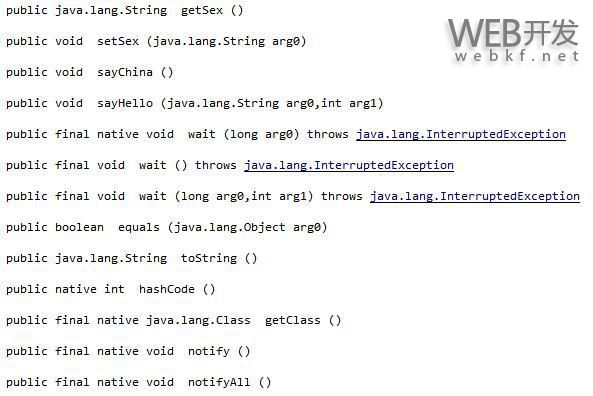
【案例】接下来让我们取得其他类的全部属性吧,最后我讲这些整理在一起,也就是通过class取得一个类的全部框架
class hello {
public static void main(String[] args) {
Class<?> demo = null;
try {
demo = Class.forName("Reflect.Person");
} catch (Exception e) {
e.printStackTrace();
}
System.out.println("===============本类属性========================");
// 取得本类的全部属性
Field[] field = demo.getDeclaredFields();
for (int i = 0; i < field.length; i++) {
// 权限修饰符
int mo = field[i].getModifiers();
String priv = Modifier.toString(mo);
// 属性类型
Class<?> type = field[i].getType();
System.out.println(priv + " " + type.getName() + " "
+ field[i].getName() + ";");
}
System.out.println("===============实现的接口或者父类的属性========================");
// 取得实现的接口或者父类的属性
Field[] filed1 = demo.getFields();
for (int j = 0; j < filed1.length; j++) {
// 权限修饰符
int mo = filed1[j].getModifiers();
String priv = Modifier.toString(mo);
// 属性类型
Class<?> type = filed1[j].getType();
System.out.println(priv + " " + type.getName() + " "
+ filed1[j].getName() + ";");
}
}
}
【运行结果】:
===============本类属性========================
private java.lang.String sex;
===============实现的接口或者父类的属性========================
public static final java.lang.String name;
public static final int age;
【案例】其实还可以通过反射调用其他类中的方法:
class hello {
public static void main(String[] args) {
Class<?> demo = null;
try {
demo = Class.forName("Reflect.Person");
} catch (Exception e) {
e.printStackTrace();
}
try{
//调用Person类中的sayChina方法
Method method=demo.getMethod("sayChina");
method.invoke(demo.newInstance());
//调用Person的sayHello方法
method=demo.getMethod("sayHello", String.class,int.class);
method.invoke(demo.newInstance(),"Rollen",20);
}catch (Exception e) {
e.printStackTrace();
}
}
}
【运行结果】:
hello ,china
Rollen 20
【案例】调用其他类的set和get方法
class hello {
public static void main(String[] args) {
Class<?> demo = null;
Object obj=null;
try {
demo = Class.forName("Reflect.Person");
} catch (Exception e) {
e.printStackTrace();
}
try{
obj=demo.newInstance();
}catch (Exception e) {
e.printStackTrace();
}
setter(obj,"Sex","男",String.class);
getter(obj,"Sex");
}
/**
* @param obj
* 操作的对象
* @param att
* 操作的属性
* */
public static void getter(Object obj, String att) {
try {
Method method = obj.getClass().getMethod("get" + att);
System.out.println(method.invoke(obj));
} catch (Exception e) {
e.printStackTrace();
}
}
/**
* @param obj
* 操作的对象
* @param att
* 操作的属性
* @param value
* 设置的值
* @param type
* 参数的属性
* */
public static void setter(Object obj, String att, Object value,
Class<?> type) {
try {
Method method = obj.getClass().getMethod("set" + att, type);
method.invoke(obj, value);
} catch (Exception e) {
e.printStackTrace();
}
}
}// end class
【运行结果】:
男
【案例】通过反射操作属性
class hello {
public static void main(String[] args) throws Exception {
Class<?> demo = null;
Object obj = null;
demo = Class.forName("Reflect.Person");
obj = demo.newInstance();
Field field = demo.getDeclaredField("sex");
field.setAccessible(true);
field.set(obj, "男");
System.out.println(field.get(obj));
}
}// end class
【案例】通过反射取得并修改数组的信息:
import java.lang.reflect.*;
class hello{
public static void main(String[] args) {
int[] temp={1,2,3,4,5};
Class<?>demo=temp.getClass().getComponentType();
System.out.println("数组类型: "+demo.getName());
System.out.println("数组长度 "+Array.getLength(temp));
System.out.println("数组的第一个元素: "+Array.get(temp, 0));
Array.set(temp, 0, 100);
System.out.println("修改之后数组第一个元素为: "+Array.get(temp, 0));
}
}
【运行结果】:
数组类型: int
数组长度 5
数组的第一个元素: 1
修改之后数组第一个元素为: 100
【案例】通过反射修改数组大小
class hello{
public static void main(String[] args) {
int[] temp={1,2,3,4,5,6,7,8,9};
int[] newTemp=(int[])arrayInc(temp,15);
print(newTemp);
System.out.println("=====================");
String[] atr={"a","b","c"};
String[] str1=(String[])arrayInc(atr,8);
print(str1);
}
/**
* 修改数组大小
* */
public static Object arrayInc(Object obj,int len){
Class<?>arr=obj.getClass().getComponentType();
Object newArr=Array.newInstance(arr, len);
int co=Array.getLength(obj);
System.arraycopy(obj, 0, newArr, 0, co);
return newArr;
}
/**
* 打印
* */
public static void print(Object obj){
Class<?>c=obj.getClass();
if(!c.isArray()){
return;
}
System.out.println("数组长度为: "+Array.getLength(obj));
for (int i = 0; i < Array.getLength(obj); i++) {
System.out.print(Array.get(obj, i)+" ");
}
}
}
【运行结果】:
数组长度为: 15
1 2 3 4 5 6 7 8 9 0 0 0 0 0 0 =====================
数组长度为: 8
a b c null null null null null
动态代理
【案例】首先来看看如何获得类加载器:
class test{
}
class hello{
public static void main(String[] args) {
test t=new test();
System.out.println("类加载器 "+t.getClass().getClassLoader().getClass().getName());
}
}
【程序输出】:
类加载器 sun.misc.Launcher$AppClassLoader
其实在java中有三种类类加载器。
1)Bootstrap ClassLoader 此加载器采用c++编写,一般开发中很少见。
2)Extension ClassLoader 用来进行扩展类的加载,一般对应的是jre\lib\ext目录中的类
3)AppClassLoader 加载classpath指定的类,是最常用的加载器。同时也是java中默认的加载器。
如果想要完成动态代理,首先需要定义一个InvocationHandler接口的子类,已完成代理的具体操作。
package Reflect;
import java.lang.reflect.*;
//定义项目接口
interface Subject {
public String say(String name, int age);
}
// 定义真实项目
class RealSubject implements Subject {
@Override
public String say(String name, int age) {
return name + " " + age;
}
}
class MyInvocationHandler implements InvocationHandler {
private Object obj = null;
public Object bind(Object obj) {
this.obj = obj;
return Proxy.newProxyInstance(obj.getClass().getClassLoader(), obj
.getClass().getInterfaces(), this);
}
@Override
public Object invoke(Object proxy, Method method, Object[] args)
throws Throwable {
Object temp = method.invoke(this.obj, args);
return temp;
}
}
class hello {
public static void main(String[] args) {
MyInvocationHandler demo = new MyInvocationHandler();
Subject sub = (Subject) demo.bind(new RealSubject());
String info = sub.say("Rollen", 20);
System.out.println(info);
}
}
【运行结果】:
Rollen 20
类的生命周期
在一个类编译完成之后,下一步就需要开始使用类,如果要使用一个类,肯定离不开JVM。在程序执行中JVM通过装载,链接,初始化这3个步骤完成。
类的装载是通过类加载器完成的,加载器将.class文件的二进制文件装入JVM的方法区,并且在堆区创建描述这个类的java.lang.Class对象。用来封装数据。 但是同一个类只会被类装载器装载以前
链接就是把二进制数据组装为可以运行的状态。
链接分为校验,准备,解析这3个阶段
校验一般用来确认此二进制文件是否适合当前的JVM(版本),
准备就是为静态成员分配内存空间,。并设置默认值
解析指的是转换常量池中的代码作为直接引用的过程,直到所有的符号引用都可以被运行程序使用(建立完整的对应关系)
完成之后,类型也就完成了初始化,初始化之后类的对象就可以正常使用了,直到一个对象不再使用之后,将被垃圾回收。释放空间。
当没有任何引用指向Class对象时就会被卸载,结束类的生命周期
将反射用于工厂模式
先来看看,如果不用反射的时候,的工厂模式吧:
/**
* @author Rollen-Holt 设计模式之 工厂模式
*/
interface fruit{
public abstract void eat();
}
class Apple implements fruit{
public void eat(){
System.out.println("Apple");
}
}
class Orange implements fruit{
public void eat(){
System.out.println("Orange");
}
}
// 构造工厂类
// 也就是说以后如果我们在添加其他的实例的时候只需要修改工厂类就行了
class Factory{
public static fruit getInstance(String fruitName){
fruit f=null;
if("Apple".equals(fruitName)){
f=new Apple();
}
if("Orange".equals(fruitName)){
f=new Orange();
}
return f;
}
}
class hello{
public static void main(String[] a){
fruit f=Factory.getInstance("Orange");
f.eat();
}
}
这样,当我们在添加一个子类的时候,就需要修改工厂类了。如果我们添加太多的子类的时候,改的就会很多。
现在我们看看利用反射机制:
package Reflect;
interface fruit{
public abstract void eat();
}
class Apple implements fruit{
public void eat(){
System.out.println("Apple");
}
}
class Orange implements fruit{
public void eat(){
System.out.println("Orange");
}
}
class Factory{
public static fruit getInstance(String ClassName){
fruit f=null;
try{
f=(fruit)Class.forName(ClassName).newInstance();
}catch (Exception e) {
e.printStackTrace();
}
return f;
}
}
class hello{
public static void main(String[] a){
fruit f=Factory.getInstance("Reflect.Apple");
if(f!=null){
f.eat();
}
}
}
现在就算我们添加任意多个子类的时候,工厂类就不需要修改。
上面的爱吗虽然可以通过反射取得接口的实例,但是需要传入完整的包和类名。而且用户也无法知道一个接口有多少个可以使用的子类,所以我们通过属性文件的形式配置所需要的子类。
下面我们来看看: 结合属性文件的工厂模式
首先创建一个fruit.properties的资源文件,
内容为:
apple=Reflect.Apple
orange=Reflect.Orange
然后编写主类代码:
package Reflect;
import java.io.*;
import java.util.*;
interface fruit{
public abstract void eat();
}
class Apple implements fruit{
public void eat(){
System.out.println("Apple");
}
}
class Orange implements fruit{
public void eat(){
System.out.println("Orange");
}
}
//操作属性文件类
class init{
public static Properties getPro() throws FileNotFoundException, IOException{
Properties pro=new Properties();
File f=new File("fruit.properties");
if(f.exists()){
pro.load(new FileInputStream(f));
}else{
pro.setProperty("apple", "Reflect.Apple");
pro.setProperty("orange", "Reflect.Orange");
pro.store(new FileOutputStream(f), "FRUIT CLASS");
}
return pro;
}
}
class Factory{
public static fruit getInstance(String ClassName){
fruit f=null;
try{
f=(fruit)Class.forName(ClassName).newInstance();
}catch (Exception e) {
e.printStackTrace();
}
return f;
}
}
class hello{
public static void main(String[] a) throws FileNotFoundException, IOException{
Properties pro=init.getPro();
fruit f=Factory.getInstance(pro.getProperty("apple"));
if(f!=null){
f.eat();
}
}
}
以上这篇java反射深入剖析(推荐)就是小编分享给大家的全部内容了,希望能给大家一个参考,也希望大家多多支持。
以上是 java反射深入剖析(推荐) 的全部内容, 来源链接: utcz.com/p/210123.html


